Drum patterns are the heartbeat of any song.
They’re the driving force that excels your tracks forward, adds depth to your music, and keeps your listeners hooked from start to finish.
Understanding and mastering drum patterns can transform your production skills 一 making your tracks shine and stand out in today’s saturated music scene.
In today’s article we’re going to dive deep into the world of drum patterns.
We’ll explore a variety of drum patterns across all the genres, providing you with the knowledge and techniques you need to step up your music production game.
But don’t worry… this isn’t just a dry, boring lesson.
I’m going to share some insider pro tips and real-world examples to help you understand how these patterns work in the context of modern music.
Here’s a sneak peek at what you’ll be learning in this article:
- The essential elements that make up a drum pattern ✓
- How to recognize/distinguish between different drum sounds ✓
- Snare drums, basses, hi-hats, and everything in between ✓
- Detailed breakdowns of the top 15 drum patterns ✓
- Examples of each drum pattern in popular modern music ✓
By the end of this guide, you’ll be armed with the knowledge and skills needed to produce hit songs with these fire drum patterns.
So, let’s dive in…
Table of Contents
- The Heartbeat of Your Track: Understanding Drum Patterns
- The Beat Essentials: Elements of Drum Patterns
- Snare, Bass, and Everything in Between
- Kickstart Your Groove: The Importance of Bass
- The Top 15 Drum Patterns For Making Hit Tracks
- #1. Four-on-the-Floor
- #2. The Two Beat
- #3. Straight Eighths
- #4. Train Beat
- #5. Trap Drum Pattern
- #6. Double Kick Drum Pattern
- #7. Samba
- #8. 16th Note Beat
- #9. Shuffle Groove
- #10. Reggae Groove
- #11. Double Time Beat
- #12. Half Time Shuffle
- #13. Motown Beat
- #14. Disco Groove
- #15. Heavy Rock Beat
- The Art of Sampling in Drum Patterns
- Developing Your Own Unique Drum Patterns
- Hip-Hop Drum Pattern: Final Thoughts
The Heartbeat of Your Track: Understanding Drum Patterns
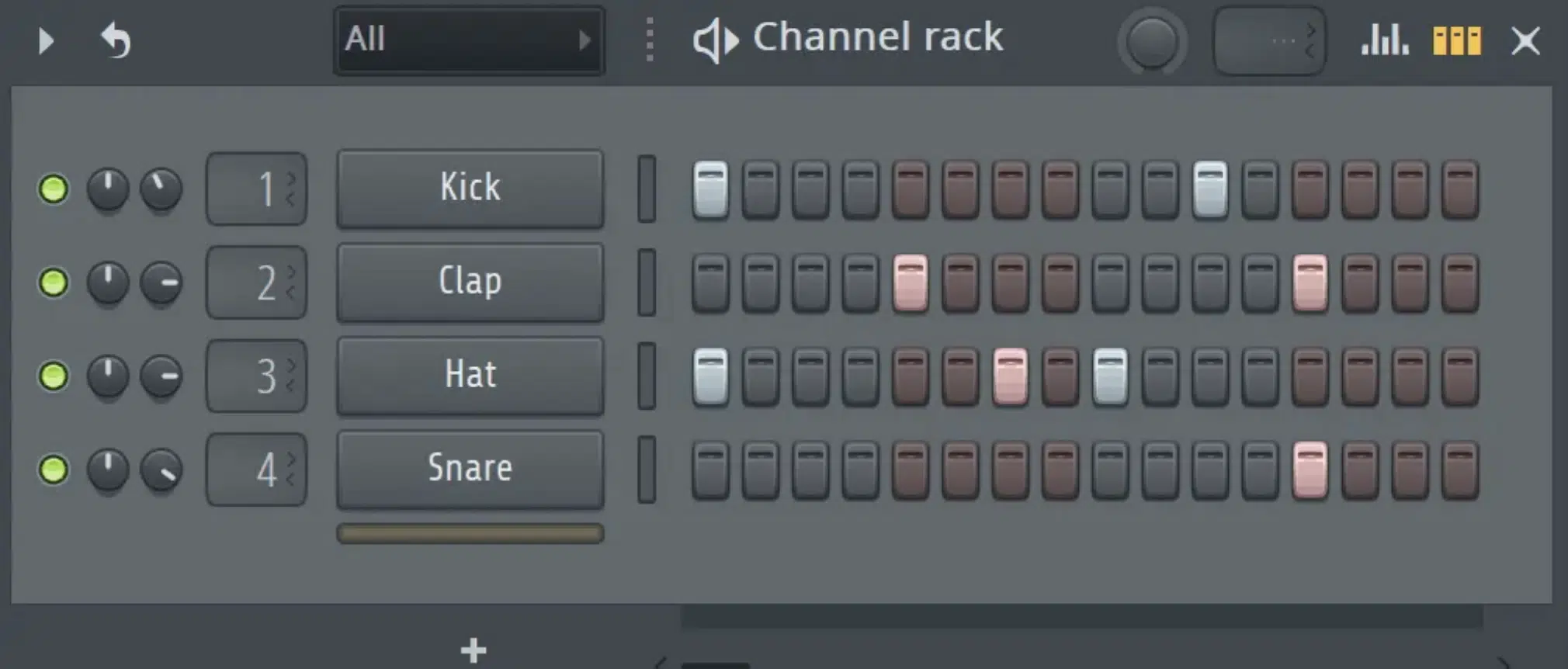
Imagine a banging hip-hop track like Travis Scott’s “SICKO MODE” without the complex trap drum pattern.
Or, a smooth R&B track like “Location” by Khalid without its relaxed, pulsing beat.
It wouldn’t work, right?… That’s because the drum patterns in those tracks aren’t just additional elements, they’re the driving force that brings your music to life.
It’s also the primary factor in determining its sonic identity.
They’re the difference between a static, flat track and one that gets heads bobbing.
Drum patterns establish a song’s groove and tempo; setting the stage for the melody and harmony to play out.
They can add energy and excitement to a track, or create a laid-back vibe that’s perfect for chilling out.
You can keep all of your instrumentation the same, but by changing the drums, you can flip the entire vibe (and even genre) of the track.
As a producer, understanding and manipulating drum patterns is like speaking the language of rhythm.
And the better you understand that language, the better your drum beats will be.
The Beat Essentials: Elements of Drum Patterns
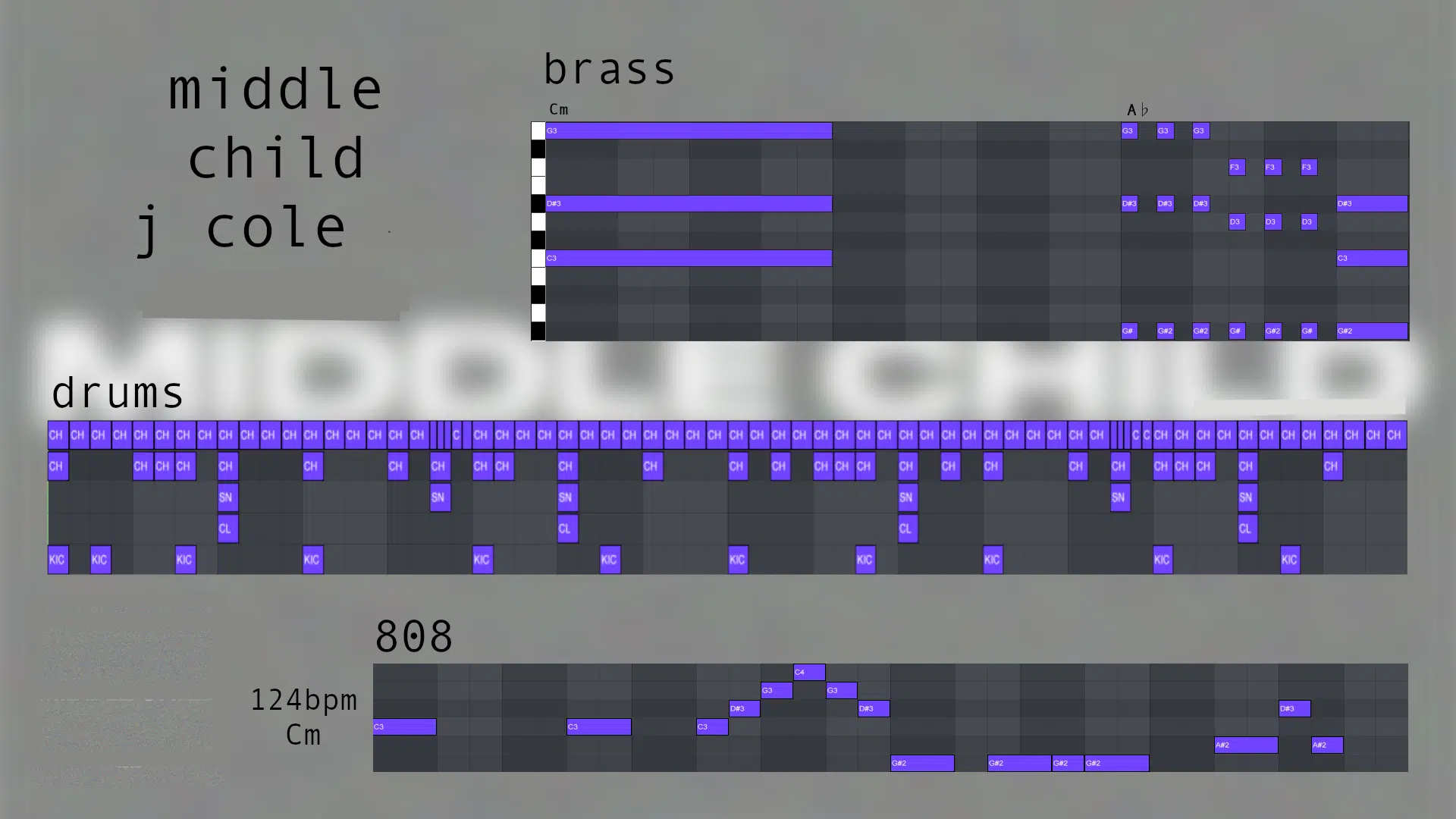
Every beat you craft is like a jigsaw puzzle, and each piece of that puzzle is a component of your hip hop drum pattern itself.
And let’s be real, some of those puzzles can get complex, especially in a hip hop drum pattern.
Take J. Cole’s “Middle Child” (above) for example, where the subtle interplay between the kick, snare, and hi-hat creates a dynamic and engaging rhythm that carries the track.
At the core of every drum pattern are the basic elements:
- Kick
- Snare
- Hi-hats
Your kick drum is your punch, the steady pulse that drives the music forward.
Your snare drum adds the crack, providing that satisfying snap on the second and fourth beats (but not exclusively on those beats, of course).
Your hi-hats keep time, dancing in between the kick and snare to fill in the spaces and add complexity to the pattern.
NOTE: If you’re strictly looking for the dopest hip-hop drum patterns in the game, look no further.
Snare, Bass, and Everything in Between

Every beat-maker knows that, when you program drum patterns, the right sounds and samples can make or break a track.
And we’ve all heard tracks where the drums just pop, like in Kendrick Lamar’s “DNA.”
The snare is crisp and punchy, the kick drum thuds in your chest, and the cymbals shimmer above it all.
But how do you achieve that?… Start by getting to know your sounds!
Each drum sound has its own variations and character, so understanding these nuances can elevate your beats to the next level.
This includes different samples of the same drum type (such as a snare) as they come in virtually endless variations, styles, and timbres.
This is why, when it comes to sound design and music production, sound selection is of the utmost importance.
The snare drum, for instance, gives your beat its defining snap.
It can be punchy and sharp for a more aggressive feel, or soft and subtle for a laid-back vibe.
The bass drum, or kick, provides the foundation of your beat.
Therefore, it should be deep and powerful, creating a rhythmic pulse that listeners can’t help but move to.
In the dynamic world of drumming, the sounds we sculpt through synthesis, sound design, and mixing form the sonic identity of your beats.
Here, we’re going to dissect the essentials:
- Bass drum
- Snares & snare patterns
- Ride cymbals
- Hi-hats
Each of these elements brings a distinct voice to the table, contributing to the overall flavor of your tracks, so let’s break it down:
-
Bass Drum Pattern
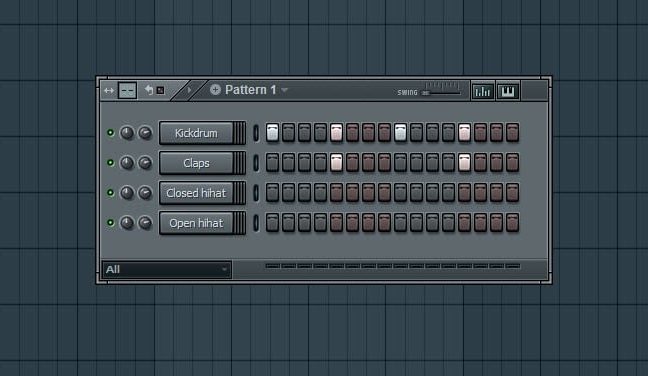
The bass drum, also known as the kick drum, this is the heartbeat of your rhythm and drum beats.
The bass drum lays down the fundamental pulse, often falling on the first and third beat.
In a hip hop drum pattern, the bass drum is usually thick and punchy, anchoring the groove with low-end power.
It’s also the main tool for creating dynamics and driving your track forward.
NOTE: In the following section we expand on the importance of bass.
-
Snare Drum (Snare Drums)
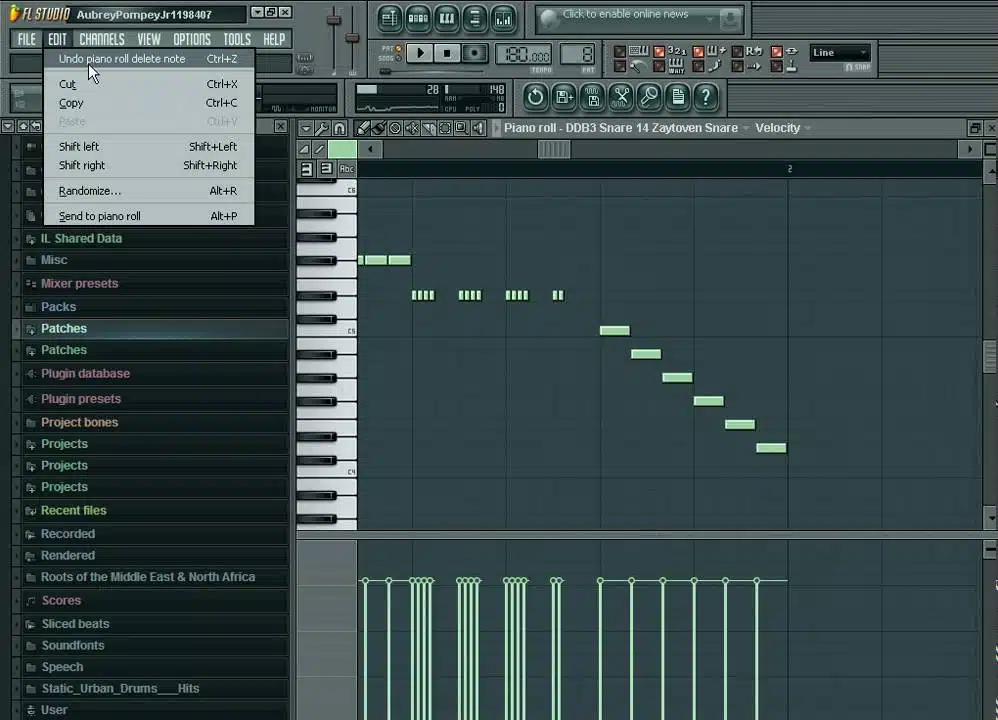
The snare drum is your rhythm’s exclamation point.
Typically landing on the second and fourth beat, the snare injects energy and helps define the ‘backbeat’ 一 a critical aspect of hip hop drum patterns.
The snare’s sharp, crisp tone cuts through the mix, giving your beat or beats a distinctive snap.
The arrangement of snare hits in your drum pattern, also known as the snare pattern (or, snare note), can greatly influence the feel of your track.
Whether it’s a steady backbeat, syncopated hits, or intricate ghost notes, snare patterns are an avenue for expressing your beat’s personality.
This is how you form a bouncing, stuttering, or rolling snare (fire!).
-
Hi-Hats
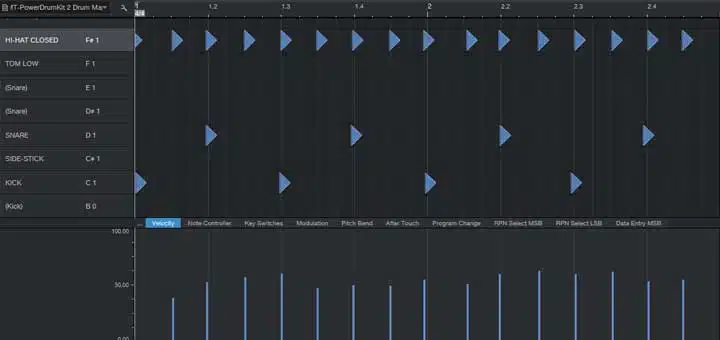
The hi-hat is the rhythmic glue holding your beat together.
Hi-hats can be closed for a sharp, ticking sound or open for a sizzling sustain.
In hip hop, complex hi-hat patterns using sixteenth or even thirty-second note rolls/stutters are common.
They add a sense of rapid movement and energy to your tracks which captivate and intrigue your audience.
You can read all about stutters and rolls in our free MIDI packs article, which includes multiple pro tips that break it down in detail.
-
Ride Cymbals
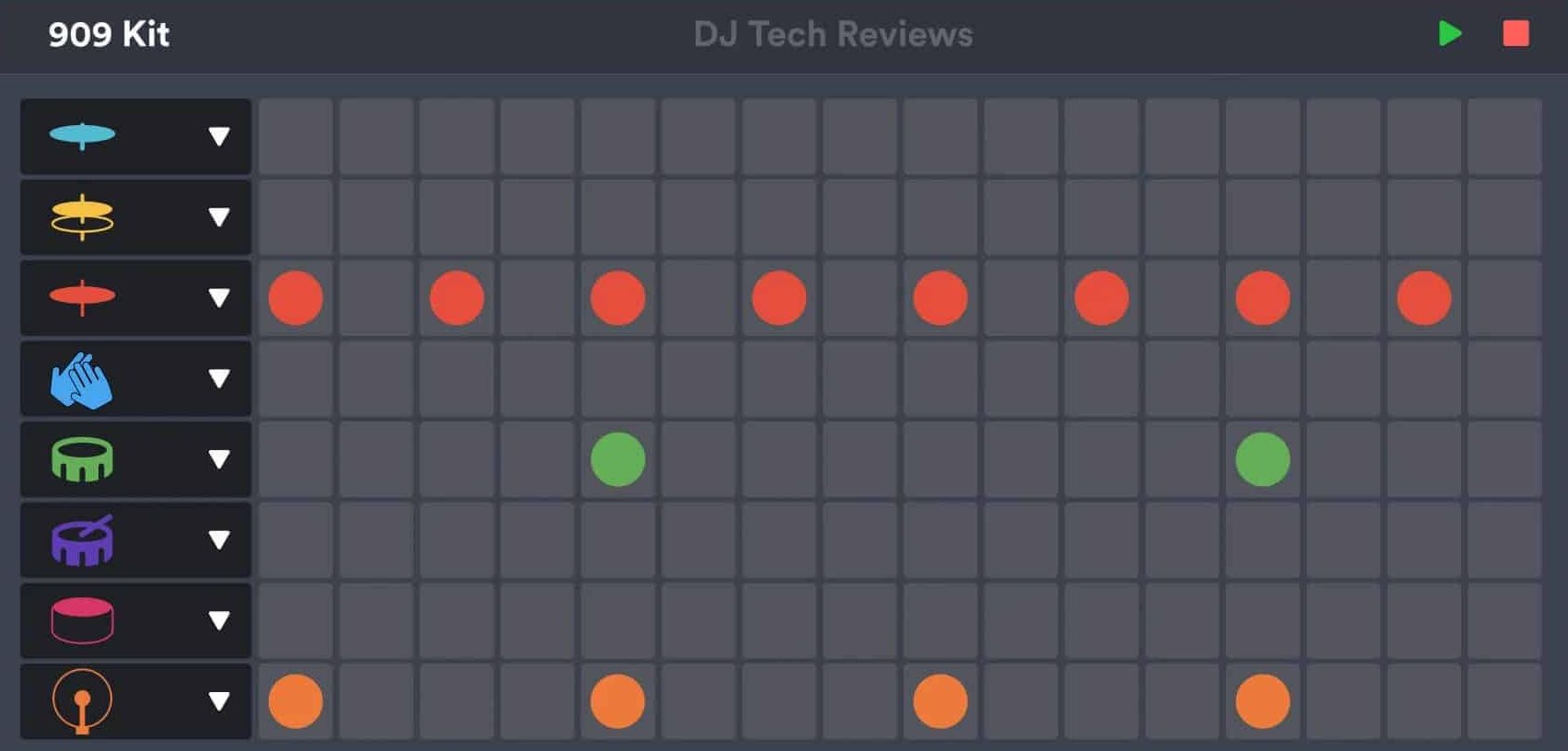
Ride cymbals bring a shimmering, sustained sound to your hip hop drum patterns.
They’re typically used for maintaining steady rhythms and adding a layer of high-end sparkle.
While not as common in hip-hop as in jazz or rock, creative use of the ride can bring a unique flavor to your beats.
Kickstart Your Groove: The Importance of Bass

In hip-hop, the bass is king.
Think about the sub-rattling low end in A$AP Rocky’s “Praise The Lord (Da Shine).”
Or, the way the bass in Cardi B’s “Bodak Yellow” perfectly complements the kick drum to create a powerful, driving rhythm.
That’s the power of bass; it’s absolutely undeniable.
Your bass drum pattern, or kick, lays the groundwork for your groove. It’s the heartbeat of your beat, providing a solid foundation that the rest of your track can build upon.
But it’s not just about having a steady pulse.
The rhythm and placement (like the first bar, second bar, etc.) of your kick can add depth and complexity to your groove.
This is what helps make your beat more engaging and interesting.
So spend some time crafting your bass drum pattern 一 it might just be the key to your next hit track.
The Top 15 Drum Patterns For Making Hit Tracks
Now that you’ve got a solid understanding of how drum patterns work, let’s jump into the fun part: the top 15 drum patterns to make your tracks knock super hard.
Regardless of what kind of genre you produce, the following drum patterns are guaranteed to make your tracks shine.
#1. Four-on-the-Floor
The four-on-the-floor drum pattern is one of the most universal beats in popular music.
You’ve heard it in house music, trance music, disco, and techno tracks 一 even in rock and pop songs.
This drum pattern gets its name from the bass drum note hitting on every beat.
So if you’re counting “1-2-3-4,” your bass drum is hitting on every one of those counts, driving the track forward with an unrelenting energy.
This is the beat that makes crowds move on the dance floor.
Its steady pulse provides the perfect foundation for synthesized melodies and powerful basslines.
As well as creates a unifying rhythm that makes it easy for DJs, like Marshmello, to blend tracks seamlessly.
Think of tracks like David Guetta’s “Titanium” or Daft Punk’s “Around the World.”
I bet your mind automatically goes to that pulsing bass drum note pounding like a heartbeat throughout the song?
That’s four-on-the-floor!
#2. The Two Beat
The two beat, sometimes referred to as the “boom-chick” pattern, is one of the most basic yet versatile drum patterns you can master.
This simple beat carries with it a rich history, transcending genres from classic country to modern pop songs.
Think of the two beat as the musical equivalent of a heartbeat: steady, reliable, and vital.
The ‘boom’ represents the kick or bass drum note on the first beat, followed by the ‘chick’ sound of the snare on the second beat.
This pattern repeats, providing a rhythmic anchor for the rest of the track.
But don’t be fooled by its simplicity… the two beat drum pattern is far from being basic or boring.
In fact, it’s used in some of the most popular music of our time.
Listen to Dua Lipa’s “Don’t Start Now” or Post Malone’s “Circles”, and you’ll hear my two favorite songs’ beat pattern reimagined in fresh, creative ways.
#3. Straight Eighths
Next up, let’s look at a pattern that’s a bit more intricate: the iconic eighths.
As the name suggests, this drum pattern revolves around eighth notes.
You’ll often find your hi-hat working overtime, hitting on every eighth note, while your bass and snare maintain a steadier pace.
This pattern is frequently heard in pop and rock tracks, creating a sense of forward momentum and excitement.
The cool thing about this drum pattern is that it’s speed (or, tempos) can dramatically alter a song’s vibe:
- A slow tempo 一 Can create a relaxed, groovy feel.
- A fast tempo 一 Can generate a sense of urgency and excitement.
Listen to the Red Hot Chili Peppers’ “Can’t Stop” – the hi-hat’s steady stream of eighth notes gives the track its infectious energy.
If you need a refresher course on music note symbols, don’t worry, we’ve got you covered.
#4. Train Beat
Get ready to pick up some speed with the train beat.
Originating in country and bluegrass, this drum beat mimics the rhythmic chug of a train rolling down the tracks.
It typically involves a snare drum playing a rapid series of beats (like the eighth notes we talked about earlier), with accents on the second and fourth beat.
This drum pattern has been used in soundtracks and songs to symbolize travel, movement, and the passing of time.
It’s an excellent storytelling tool in the hands of a skilled songwriter or composer.
If you want a prime example, listen to Johnny Cash’s “Folsom Prison Blues” – that relentless, chugging rhythm is the train beat in action.
“Old Town Road” by Lil Nas X is a more modern example of a song that uses the “train beat” pattern.
While it leans more towards country, the beat helped the song cross over to pop and hip-hop audiences.
Which proves that the train beat can be versatile and still relevant in modern music production.
#5. Trap Drum Pattern
Stepping back into the world of hip-hop, the trap drum pattern is a relatively recent addition to the wide variety of essential drum beats.
One of the most distinctive characteristics of trap drum patterns is the use of rapid-fire hi-hats.
Producers often use sixteenth or even thirty-second notes to create this effect, generating a flurry of hi-hat hits that deliver a sense of urgency and drive.
Listen to Migos’ “Bad and Boujee” or Future’s “Mask Off”, and you’ll hear the complexity of these hi-hat patterns creating a mesmerizing rhythmic foundation.
The kick & snare in a trap beat also plays a vital role.
The kick, or bass drum, often employs an 808 sound (drum n bass), named after the iconic Roland TR-808 drum machine.
These 808s are usually tuned and extended to create a bass line that rumbles and resonates, like the one you can hear in Travis Scott’s “Goosebumps”.
The snare drum, on the other hand, often lands on the third beat, but it’s also used in rapid-fire sequences to match the hi-hats, as you can hear in tracks like Desiigner’s “Panda”.
Side note, while we’re on the subject of trap, if you’re wondering what the top 8 trap chord progressions are, we got you covered.
#6. Double Kick Drum Pattern
Next on our list is the double kick drum pattern, a staple of heavy rock and metal genres.
As the name suggests, this drum pattern is characterized by rapid, alternating hits on the bass drum, giving a driving, powerful feel to the beat.
Double kicks highlight intense passages or to sync up with complex guitar riffs, creating a tight, full sound that resonates with energy and power.
One of the best-known examples of the double kick drum pattern can be found in Metallica’s “One”.
Those rapid-fire bass drum notes are the foundation of the song’s intense, energetic rhythm.
If you’re a hip-hop producer, one of the cool things you can do is incorporate this type of pattern during the chorus (a trick of Lil Waynes’) to add some unique, fascinating qualities.
If you’re looking for the absolute best free drum kits of 2023, look no further.
#7. Samba
The best way I can describe the samba pattern is by saying it feels like a rhythmic trip to Brazil.
This groove is characterized by a syncopated bass drum pattern, playing on the “ands” or offbeats, giving the samba its iconic forward-moving feel.
Combine that with a driving snare or rim-click pattern on the second and fourth beat (quarter notes), and you have a beat that’s ready to make people move.
Samba patterns are often accompanied by a host of different percussion instruments, each adding their own unique rhythm.
This layered effect contributes to the dense, rich tapestry of sound that defines Brazilian music. “Mas Que Nada” by Jorge Ben Jor is a great example of the samba rhythm in action.
A good recent example is the track “Taki Taki” by DJ Snake featuring Selena Gomez, Ozuna and Cardi B.
While the track is not strictly samba, its percussive rhythm certainly draws inspiration from Latin beats like the samba.
Which demonstrates the pattern’s potential for crossover appeal in modern music.
#8. 16th Note Beat
Moving on to a more complex pattern, the 16th note beat has the hi-hat playing 16th notes while the kick and snare maintain a steadier rhythm.
This gives the drum beat itself a sense of urgency, drive, and intrigue.
The intricate hi-hat work in a 16th note beat is a key factor in the funky, upbeat feel of many funk and disco tracks.
This pattern has a forward momentum that encourages movement and dance, making it ideal for any energetic music.
The drum pattern in “Bad and Boujee” by Migos relies on sixteenth-note hi-hats to build tension & release and gives it that distinctively funky feel.
#9. Shuffle Groove
Let’s slow things down with the laid-back feel of the shuffle groove.
This pattern is characterized by a “triplet” feel, where the first and third note of each triplet is played, creating a distinctive swing.
You’ll often hear this beat in blues, jazz, and old-school rock n’ roll.
The ‘swing’ feel it provides was revolutionary in its time and paved the way for much of modern popular music.
Stevie Ray Vaughan’s “Pride and Joy” is a perfect example of the shuffle groove in action.
Also, Bruno Mars’ “That’s What I Like” demonstrates the shuffle rhythm in a more modern pop context.
#10. Reggae Groove
The reggae groove is all about the offbeat.
This pattern often features the snare or rim click and hi-hat playing on the ‘offbeats,’ giving reggae its signature laid-back, syncopated feel.
The reggae groove’s emphasis on the offbeat is a nod to its African roots, where syncopation is a key feature of traditional music.
This pattern’s laid-back feel captures the relaxed, sunny vibe of the Caribbean, where reggae originated.
A classic example of the reggae groove is Bob Marley’s “Jammin'”.
Well, pretty much anything by Bob Marley perfectly sums up this drum pattern’s unique, chill vibe.
#11. Double Time Beat
Double time is all about creating the sensation of speed without increasing the actual tempo.
In this pattern, the snare hits on the third beat, while the hi-hat or ride cymbal is playing eighth notes 一 making it feel as though the beat is moving twice as fast.
Double time beats are common in punk rock music, where the speed and energy they provide help drive the high-intensity feel of the genre.
They’re also used in dramatic moments in film scores to raise the adrenaline levels of the viewers.
You can hear a clear example of a double time beat when you listen to the hip hop drum pattern in God’s Plan” by Drake, which added energy and hype to the track.
#12. Half Time Shuffle
The half-time shuffle is a favorite among drummers for its complex, syncopated rhythm and ‘lazy’ feel.
The snare hits on the third beat while the hi-hat maintains a constant triplet shuffle.
This gives the beat a laid-back, ‘dragging’ feel.
The complexity and syncopation of the half-time shuffle pattern make it a favorite among experienced drummers looking for a true challenge.
It’s also used in slow-burning rock songs and blues numbers to create a ‘strutting’ feel.
The legendary “Rosanna” by Toto, with Jeff Porcaro on drums, is an excellent showcase of the half-time shuffle.
A more recent example would be the song “Sorry” by Justin Bieber.
It uses a reggae-inspired groove, adding an unexpected twist to the pop hit.
#13. Motown Beat
This pattern features a strong backbeat on the snare, typically with the bass drum landing on the first and third beat, and an eighth-note pattern on the hi-hat or ride cymbal.
The driving rhythm and steady pace of this pattern made it a favorite among Motown producers in the 1960s and 70s.
The Motown beat’s consistent, driving rhythm helped create a sense of unity among the diverse range of artists on the Motown label.
Its energetic feel embodied the spirit of optimism and change that defined the 1960s.Marvin Gaye’s “I Heard It Through the Grapevine” offers a masterclass in the Motown beat.
The Weeknd’s “Blinding Lights” pulls from the Motown era as well with a simple, driving beat reminiscent of the iconic Motown sound.
#14. Disco Groove
The disco groove is characterized by a steady four-on-the-floor kick drum, offbeat hi-hats, and an open hi-hat on the last offbeat of each bar.
Often, there’s also a snare drum on the second and fourth beats.
This pattern is quintessential for tracks that get people moving and grooving on the dance floor.
The disco groove also played a significant role in the dance music revolution of the 1970s.
The open hi-hat on the offbeat was a new development that added a fresh, unique sound, helping to distinguish disco from other genres.
You can find a stellar example of a disco groove in the classic “Stayin’ Alive” by the Bee Gees.
It’s that persistent, dance-inducing beat that drives the whole track.
#15. Heavy Rock Beat
Lastly, we’re heading into the world of heavy rock.
Heavy rock drum patterns are typically characterized by:
- A driving rhythm; often with a steady eighth-note pattern on the hi-hat or ride
- A snare on the second and fourth beats
- A prominent, powerful kick drum
The heavy rock beat’s loud, powerful style symbolizes the rebellious spirit of rock music.
Its intense energy level made it the perfect foundation for the distorted electric guitars and passionate vocals that define the genre.
An iconic example of this can be found in Led Zeppelin’s “Kashmir.”
John Bonham’s powerful drumming provides a robust, driving rhythm that gives the track its distinctive heavy rock feel.
The Art of Sampling in Drum Patterns
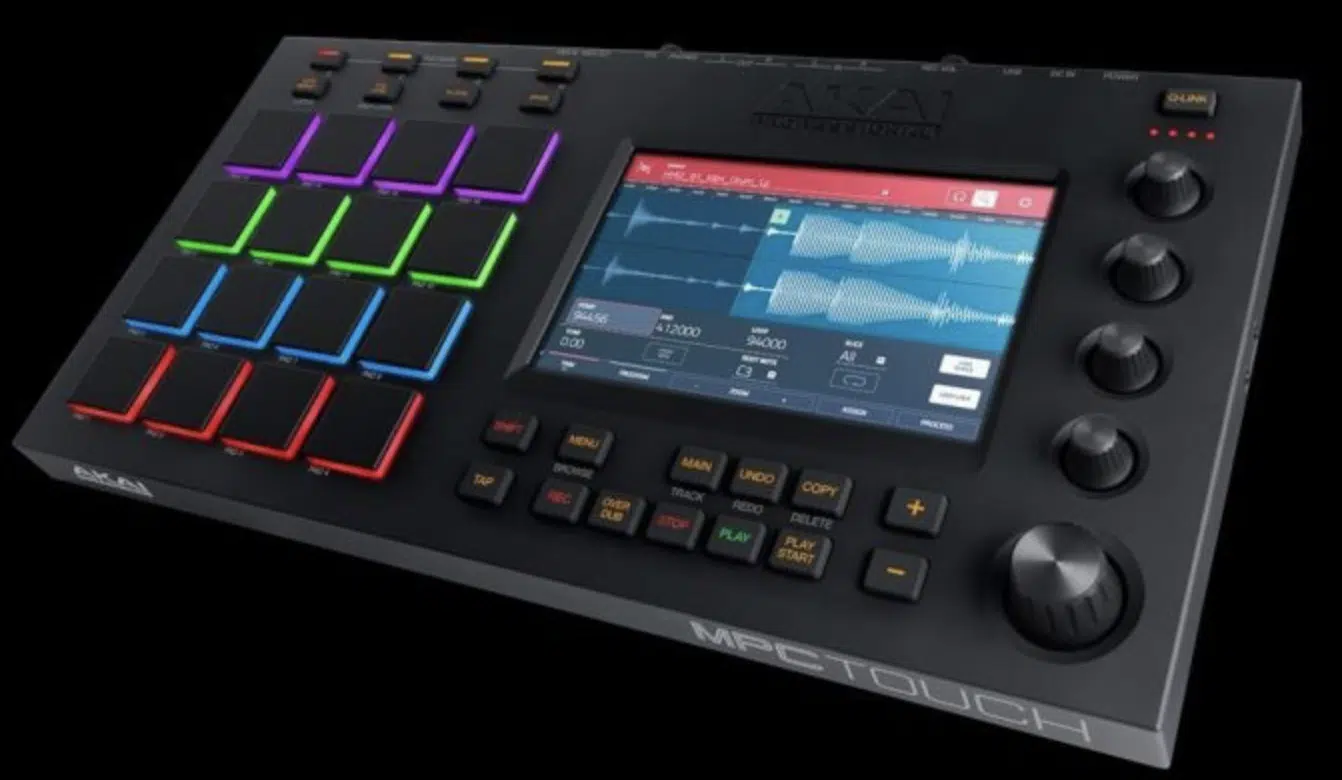
Sampling is a fundamental part of modern music production, and it’s especially crucial in drum patterns.
With samples, you can take a drum sound from any source — a classic funk break, a snare hit from your favorite song, even a sound you recorded yourself — and use it in your own tracks.
When you’re choosing drum samples, pay attention to the sound and the vibe of each sample.
Ask yourself:
- Does it fit with the style of your track?
- Does it have the right feel: punchy, laid-back, aggressive, smooth?
- Does it reflect my personal vibe?
Remember, it’s not just about the rhythm; the sound of your drums can make or break your track.
Therefore, choosing the right ones are super important.
If you’re looking for the best free sample packs of 2023, look no further.
-
Creative Sampling Techniques
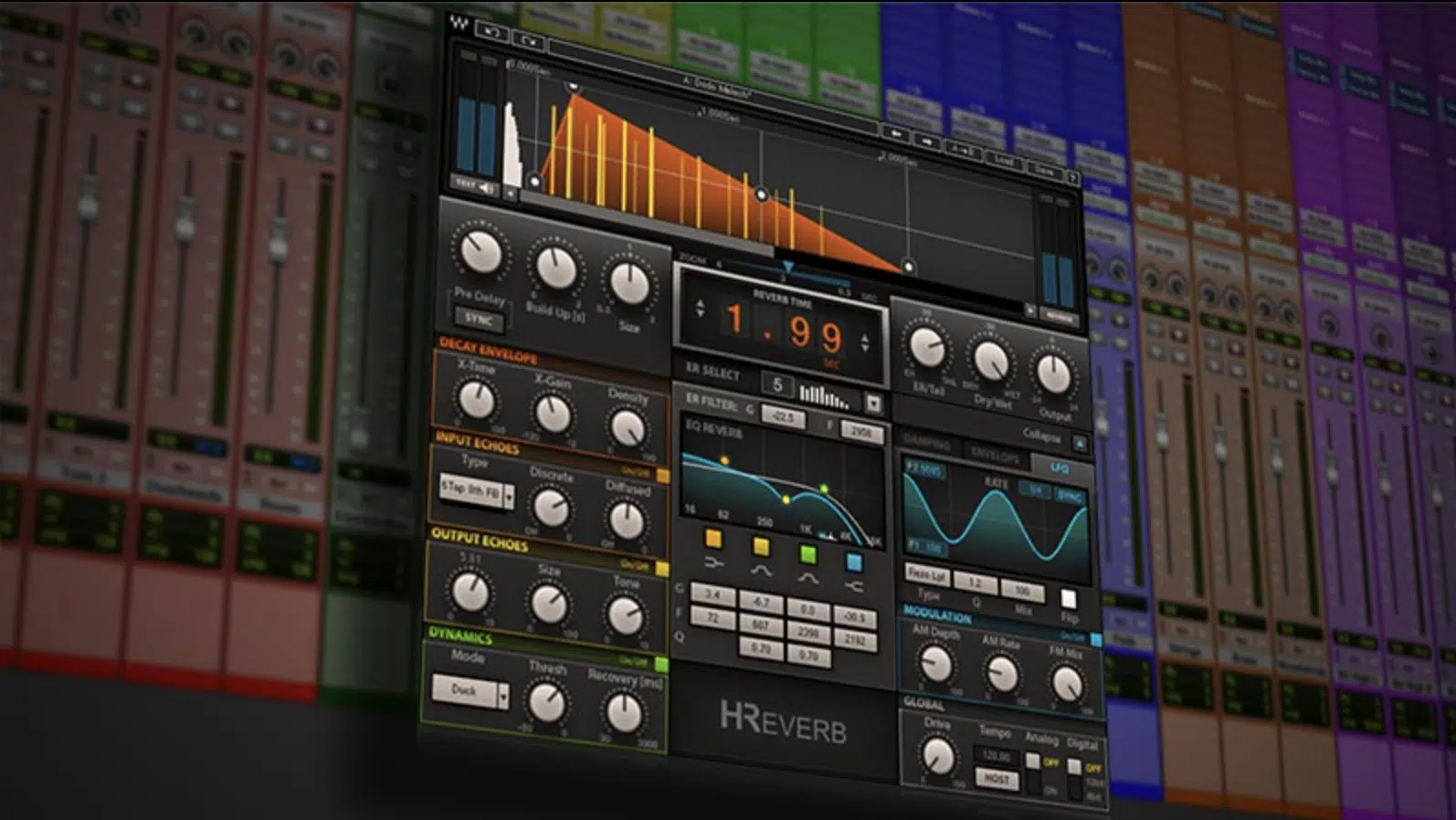
Once you’ve chosen your samples, you can manipulate them to create your own unique drum sounds.
Try pitching a sample up or down for a different tone, or layer multiple samples together to create a rich, complex sound.
You can also use effects like reverb, delay, distortion, and compression to shape your drum sounds.
A little bit of reverb can make a snare drum sound huge and epic.
While distortion can give a kick drum a gritty, aggressive edge.
With sampling, the possibilities are endless — you’re only limited by your imagination.
Developing Your Own Unique Drum Patterns
Now that you’re aware of all the different drum patterns, let’s dive into how to make your very own unique drum patterns!
-
Variations and Experimentation
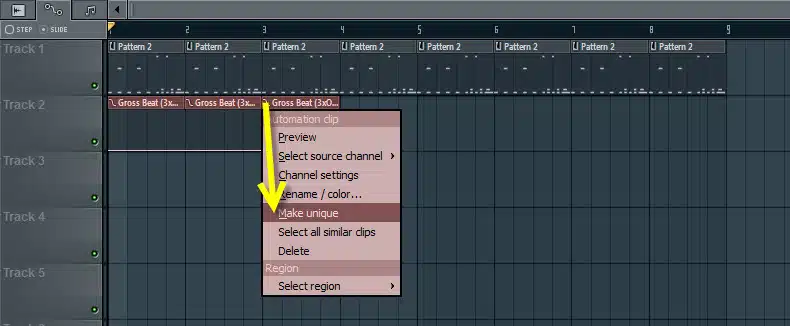
Learning to create your own variations is crucial in developing unique drum patterns.
Don’t be afraid to experiment and break the rules, especially when dealing with a hip hop drum pattern.
Maybe that means moving your snare hit to the first beat, adding a double kick on the fourth, or scattering ghost notes throughout your pattern.
Also, keep in mind that different genres and subgenres have their own characteristic drum patterns.
Hip hop, for example, often uses a kick on the first and third beat and a snare on the second and fourth.
On the other hand, house music typically features a four-on-the-floor bass drum pattern.
Understanding these conventions can help you create drum patterns that fit the vibe of your track, or even subvert expectations for a fresh sound.
-
Drawing Inspiration from Your Favorite Songs
One of the best ways to improve your drum patterns is to draw inspiration from your favorite songs.
Listen to how the drummer or producer uses the snare, bass drum, and hi-hat to create a groove.
Then, try to recreate their patterns in your own music to get a stronger understanding of how the process works.
This can be a great way to learn new drum beats techniques and develop your own style.
-
Playing with Tempo & Swing
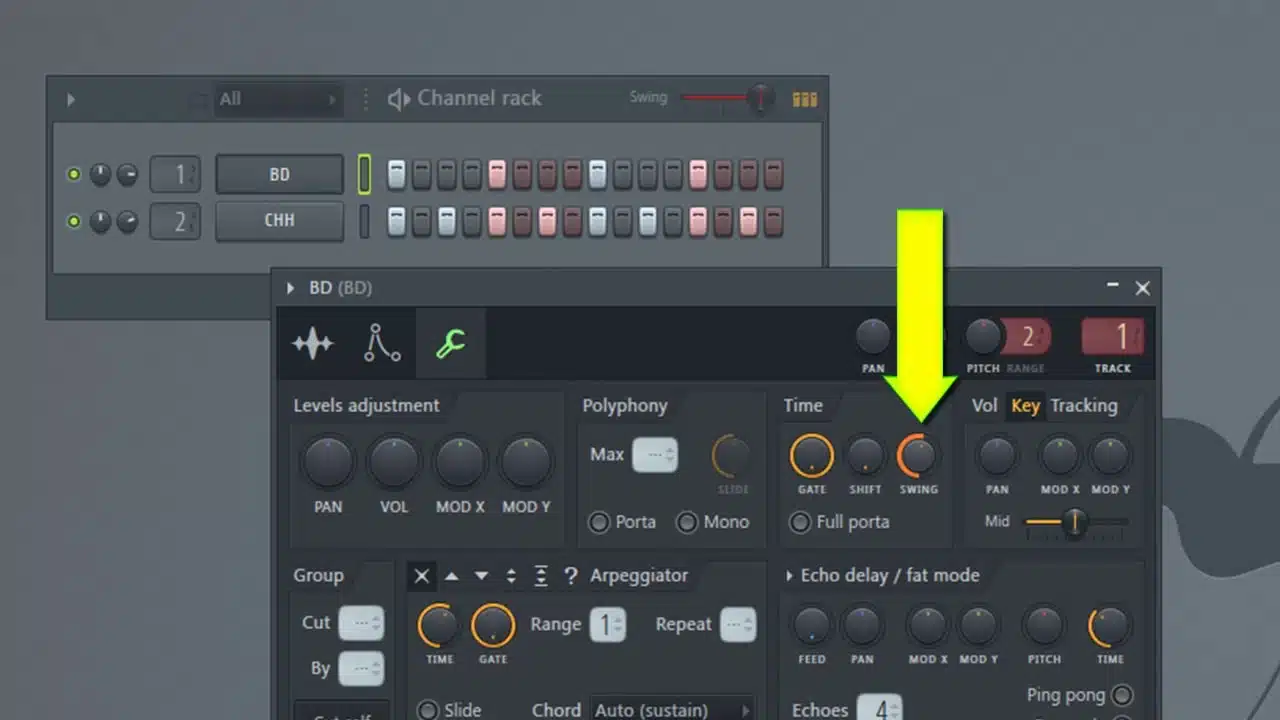
Switching up the tempo or adding a touch of swing can dramatically change the feel of your drum patterns.
- High tempos can make your track feel energetic and intense.
- Slower tempos can lend a relaxed, laid-back vibe.
Swing, on the other hand, adds a bit of rhythmic “bounce” to your patterns, perfect for genres like jazz, hip hop, or lo-fi.
Try changing the tempo or adding swing to your next drum pattern and see how it changes the vibe.
Just remember, there’s no right or wrong tempo or swing — it’s all about what feels right for the track.
Hip-Hop Drum Pattern: Final Thoughts
And there you have it: your ultimate guide to the top 15 drum patterns for any occasion, genre, and vibe.
Understanding and implementing these drum patterns in your tracks is not just a step, it’s a leap towards creating billboard hits.
They’re the rhythmic blueprint that lays the foundation of your tracks, setting the tone, pace, and feel of your music.
By mastering these patterns, you’ll elevate your beat-making skills and turn your beats into addicting tracks that will resonate with your listeners.
But the drum pattern journey doesn’t stop here… There’s a vast world of rhythm to explore, an endless spectrum of beats waiting for you to discover and make your own.
So, keep experimenting, keep learning, and above all, keep creating.
To give you a head start on this journey, download this free MIDI drum kits pack, which comes with 5 complete MIDI drum kits by the world’s top producers.
Many of the drum patterns we’ve explored throughout this article are represented in this pack — perfectly crafted and ready for you to analyze, replicate, and tweak to your liking.
It’s an invaluable tool that can accelerate your understanding of drum patterns and offer you a hands-on experience that truly brings the theory to life.
Remember, music production is a marathon, not a sprint.
It’s about growth, persistence, and the courage to express your unique voice.
So, drum up your passion (pun intended), follow the beat of your creativity, and you’ll find yourself making music that truly shines.
Until next time…








Leave a Reply
You must belogged in to post a comment.